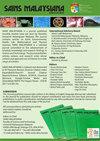黄芪抗癌活性、相关植物化学物质及潜在分子机制的研究进展
IF 0.7
4区 综合性期刊
Q3 MULTIDISCIPLINARY SCIENCES
引用次数: 0
摘要
耐药性是导致抗癌药物治疗失败的主要问题。这一问题促使研究人员从药用植物中寻找新的物质,据广泛报道,药用植物是抗癌剂的良好来源。印度角鲨是一种属于Combretaceae科的植物,被称为Rangoon Creeper,在热带国家可以大量发现,并作为野生灌木大量分布。传统上,它被广泛使用,科学上声称它可以处理各种治疗活动。最近有报道称,它对不同的癌症具有各种潜在的抗癌活性。从几乎所有季节的可用性和快速生长来看,它是经济上发现抗癌药物的草药来源。此外,印度黄富含几种感兴趣的次级代谢产物,这是其抗癌潜力的积极发现的原因。在这篇综述中,我们的目的是解读和讨论在临床前模型中证明的印度黄粗提取物和分离的植物化学物质的抗癌活性,以及相关的分子机制。在转化为临床测试之前,应该对其抗癌潜力进行更多的临床前研究。本文章由计算机程序翻译,如有差异,请以英文原文为准。
Insights on Anticancer Activities, Associated Phytochemicals and Potential Molecular Mechanisms of Quisqualis indica: A Mini Review
Drug resistance is the main issue causing the treatment failure of anticancer drugs. This issue has urged researchers to search for new substances from medicinal plants, which are widely reported as the good sources of anticancer agents. Quisqualis indica is a plant belongs to Combretaceae family, known as Rangoon Creeper, which can be found abundantly in tropical countries and distributed profusely as a wild shrub. It has been widely used traditionally and scientifically claimed to process various therapeutic activities. It has recently been reported to possess various potential anticancer activities against different cancers. Looking at its availability in almost all seasons and grow fast, it is an arising source of herbal medicine in the discovery of anticancer drugs economically. Besides, Q. indica is enriched with several secondary metabolites of interest, which are responsible for the positive findings for its anticancer potentials. In this review, we aim to decipher and discuss the anticancer activities of Q. indica crude extracts and isolated phytochemicals as evidenced in preclinical models, as well as the associated molecular mechanisms. More preclinical investigations on its anticancer potentials should be conducted before translation to clinical testing.
求助全文
通过发布文献求助,成功后即可免费获取论文全文。
去求助
来源期刊

Sains Malaysiana
MULTIDISCIPLINARY SCIENCES-
CiteScore
1.60
自引率
12.50%
发文量
196
审稿时长
3-6 weeks
期刊介绍:
Sains Malaysiana is a refereed journal committed to the advancement of scholarly knowledge and research findings of the several branches of science and technology. It contains articles on Earth Sciences, Health Sciences, Life Sciences, Mathematical Sciences and Physical Sciences. The journal publishes articles, reviews, and research notes whose content and approach are of interest to a wide range of scholars. Sains Malaysiana is published by the UKM Press an its autonomous Editorial Board are drawn from the Faculty of Science and Technology, Universiti Kebangsaan Malaysia. In addition, distinguished scholars from local and foreign universities are appointed to serve as advisory board members and referees.
 求助内容:
求助内容: 应助结果提醒方式:
应助结果提醒方式:


